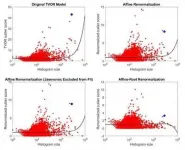(Press-News.org) Aerospace engineering faculty member Melkior Ornik is also a mathematician, a history buff, and a strong believer in integrity when it comes to using hard science in public discussions. So, when a story popped up in his news feed about a pair of researchers who developed a statistical method to analyze datasets and used it to purportedly refute the number of Holocaust victims from a concentration camp in Croatia, it naturally caught his attention.
Ornik is a professor in the Department of Aerospace Engineering at the University of Illinois Urbana-Champaign. He proceeded to study the research in depth and used the method to re-analyze the same data from the United States Holocaust Memorial Museum. Then he wrote a rebuttal paper debunking the researchers' findings.
Ornik's rebuttal is published in the same journal as the original article. He said the editor asked him to include a list of answers to some of the potential questions other scientists may have when they read his paper. A few weeks later, the journal placed a note on the original article stating that they do not endorse or share the authors' views, and recommended reading Ornik's paper.
"As scientists, as engineers, I think it's our duty to correct flawed and faulty science," Ornik said. "There is so much effort to get the public and policymakers to believe in the science, that when a math expert says they have proof, it brings credence to the argument. But when their claims are demonstrably not true, it's not good for science and it's not good for society. That's why it's especially important for scientists to challenge false findings when we discover them."
According to Ornik, some individuals promote the view that concentration camps either didn't exist or weren't used to kill people, or that the currently widely accepted numbers of victims have been substantially inflated. Most historians do not take the claims seriously in light of vast available data and evidence.
"For the authors of the original paper to claim that they have found mathematical proof that the list of victims of that camp was fabricated has obvious historical implications," Ornik said. "I think, to some extent the damage has already been done, but I felt the need to go on record with the assumptions, inaccuracies, and misuse of the raw museum data I found in the original research."
The paper Ornik responded to presents a novel method to identify anomalies across a set of histograms. Ornik said he does not dispute the merits of the method presented in the original paper, just its application to the Jasenovac concentration camp.
Ornik became suspicious of the paper's conclusions because the researchers implied in one case that a smaller list naturally has a smaller outlier score, but they compared scores across victim list sizes to claim that the one related to Jasenovac, one of the biggest ones, was problematic.
"I started looking to see if there was some sort of a bias for the size and whether they were actually more likely to assign the flag of being problematic to a larger list or not. And it turns out, despite the authors' claims, they were," Ornik said. "The bigger lists are more likely to be computed to be problematic than the smaller lists when their method is applied to the data."
Ornik, who commonly uses similar statistical analysis in aerospace applications, explained another reason that their statistical argument doesn't work.
"When you look at data, a collection of anything, and you want to figure out an outlier--something that's different--you need to assume that all of the pieces of data come from the same source, the same distribution. Take a list of victims by birth year. It would yield a graph of the ages of each person. Say 10 percent are older than 70 years old. Now, that distribution wouldn't be true for a list of deported children, for example, because that list, by definition, is structurally different. It is also different from a list of everyone who has an identity card. Identity cards are issued only to people who are not children. Yet, the lists that these researchers worked with came from a multitude of sources and include lists of children, lists of people getting married, lists of prisoners of war--things that by definition cannot have come from the same distribution."
Another major error in the original paper, Ornik said, is that some duplicate lists were treated as two separate lists. This meant that approximately 67 percent of their entire database was actually sub-lists of the larger list.
"The 7,000-plus lists published online by the Holocaust Museum are not curated," Ornik said. "For instance, there are two lists that contain exactly the same data; one is in Cyrillic and the other one uses the Latin alphabet. But they treated them as two separate lists. There are other lists that contain the same name, but there is no way of knowing if they are the same person or two different people born on the same day with identical names. They could have removed the very egregious errors in which a list is clearly duplicated but the rest, you would need access to the original historic data."
Both the original paper and Ornik's paper, "Comment on "TVOR: Finding Discrete Total Variation Outliers Among Histograms," are published in IEEE Access.
INFORMATION:
ROCHESTER, Minn. -- Mayo Clinic researchers are taking a close look at rare cases of inflammation of the heart muscle, or myocarditis, in young men who developed symptoms shortly after receiving the second dose of the Moderna or Pfizer messenger RNA (mRNA) COVID-19 vaccines. Several recent studies suggest that health care professionals should watch for hypersensitivity myocarditis as a rare adverse reaction to being vaccinated for COVID-19. However, researchers stress that this awareness should not diminish overall confidence in vaccination during the current pandemic.
While reports of post-vaccine myocarditis ...
Using real-time deformability cytometry, researchers at the Max-Planck-Zentrum für Physik und Medizin in Erlangen were able to show for the first time: Covid-19 significantly changes the size and stiffness of red and white blood cells - sometimes over months. These results may help to explain why some affected people continue to complain of symptoms long after an infection (long Covid).
Shortness of breath, fatigue and headaches: some patients still struggle with the long-term effects of a severe infection by the SARS-CoV-2 coronavirus after six months or more. This post Covid-19 syndrome, also called long covid, is still not properly understood. What is clear is that -- during the ...
In two journal articles, a University of Houston biomedical researcher reports a step forward in diagnosing intestinal diseases, including colorectal cancer, ulcerative colitis and Crohn's disease using stool proteins. The current gold standard for colon cancer testing measures blood (hemoglobin) present in stool, and tests for inflammatory bowel disease (IBD) measure levels of calprotectin, a protein that detects inflammation in the intestines.
"The unique aspect of both research reports is that we are looking at stool samples comprehensively, ...
INDIANAPOLIS - Ten IU School of Medicine researchers out of a team of 11 scientists, are responsible for the findings of a new study they conducted to investigate alternative ways to treat kidney infections. Their work, which is published in the high-quality research journal Nature Communications, examined how to utilize the kidneys' own internal infection fighting capabilities to treat and even prevent kidney infections, with the knowledge that eventually antibiotics won't work.
According to statistics, urinary tract infections or UTIs are one of the most frequent bacteria-causing ...
A new class of illusion, developed by a visual artist and a psychology researcher, underscores the highly constructive nature of visual perception.
The illusion, which the creators label "Scintillating Starburst," evokes illusory rays that seem to shimmer or scintillate--like a starburst. Composed of several concentric star polygons, the images prompt viewers to see bright fleeting rays emanating from the center that are not actually there.
"The research illustrates how the brain 'connects the dots' to create a subjective reality in what we see, highlighting the constructive nature of perception," explains Pascal Wallisch, a clinical associate professor in New York University's Department ...
Six antibody characteristics could help scientists identify which pregnant women are at risk of placental malaria infections, finds a study published today in eLife.
Malaria infections can be devastating for pregnant mothers, particularly during their first pregnancies. If malaria parasites invade the placenta, they can starve babies of nutrition, potentially causing low birth weight, preterm deliveries, stillbirths, and pregnancy loss. But not all women are susceptible to placental malaria infections, and the new study may help clinicians to identify those at risk and researchers to develop new therapies to protect pregnant women from malaria and related complications.
A protein made by malaria parasites called VAR2CSA allows them to attach ...
New insight on how our experiences during a task or interaction shape our current mood has been published today in the open-access eLife journal.
The study suggests that early experiences may have a larger effect on our mood than more recent events. These findings hold implications for the timing of events in experimental or clinical settings, and suggest new directions for mood interventions tailored to individual patients.
People routinely report on their moods during everyday activities and when they interact with clinicians providing mental health care. It is commonly believed ...
Rising nighttime temperatures are curbing crop yields for rice, and new research moves us closer to understanding why. The study found that warmer nights alter the rice plant's biological schedule, with hundreds of genes being expressed earlier than usual, while hundreds of other genes are being expressed later than usual.
"Essentially, we found that warmer nights throw the rice plant's internal clock out of whack," says Colleen Doherty, an associate professor of biochemistry at North Carolina State University and corresponding author of a paper on the work.
"Most people think plants aren't dynamic, but they are. Plants are constantly regulating ...
A recent proof-of-concept study finds that a low-cost training program can reduce hazardous driving in older adults. Researchers hope the finding will lead to the training becoming more widely available.
"On-road training and simulator training programs have been successful at reducing car accidents involving older drivers - with benefits lasting for years after the training," says Jing Yuan, first author of the study and a Ph.D. student at North Carolina State University. "However, many older adults are unlikely to have access to these training programs or technologies."
"We developed a training program, ...
Populations of Drosophila suzukii fruit flies - so-called "spotted-wing Drosophila" that devastate soft-skinned fruit in North America, Europe and parts of South America - could be greatly suppressed with the introduction of genetically modified D. suzukii flies that produce only males after mating, according to new research from North Carolina State University.
D. suzukii are modified with a female-lethal gene that uses a common antibiotic as an off switch. Withholding the antibiotic tetracycline in the diet of larvae essentially eliminates birth of female D. suzukii flies as the modified male flies successfully mate with females, says Max Scott, an NC State entomologist who is the corresponding author of a paper describing the research.
"We use a genetic female-lethal system - a ...


